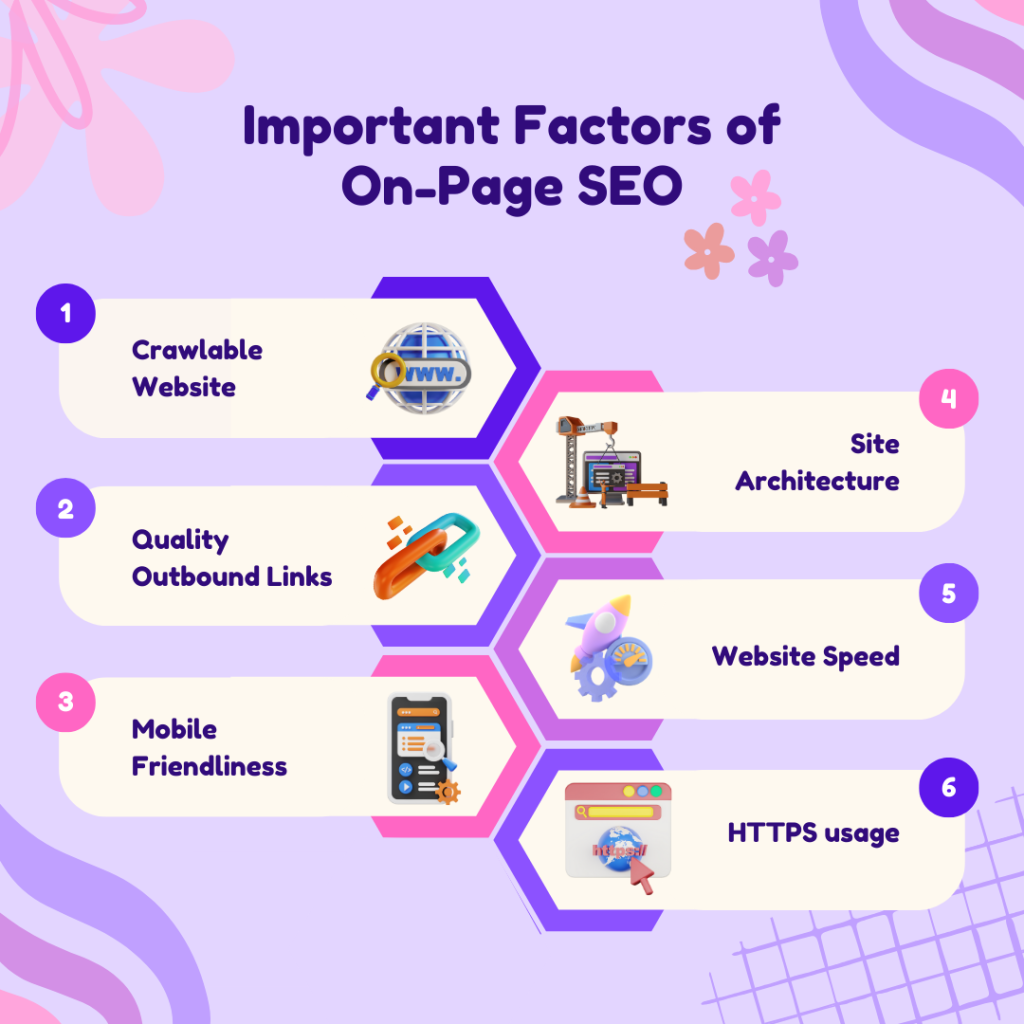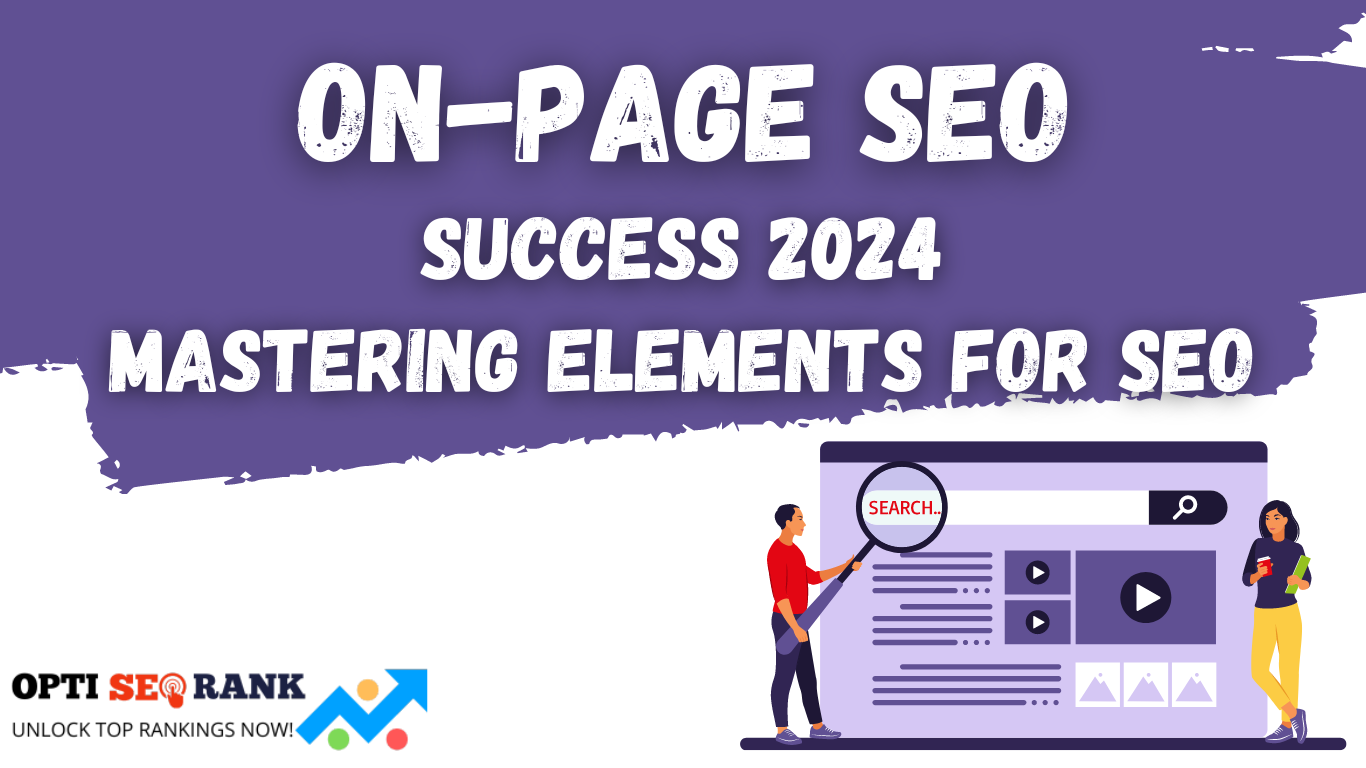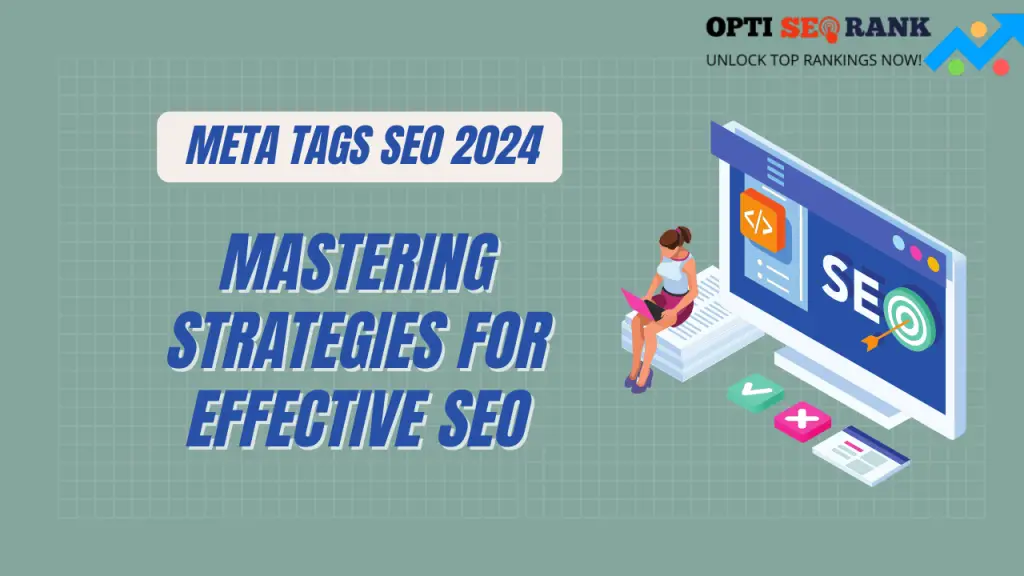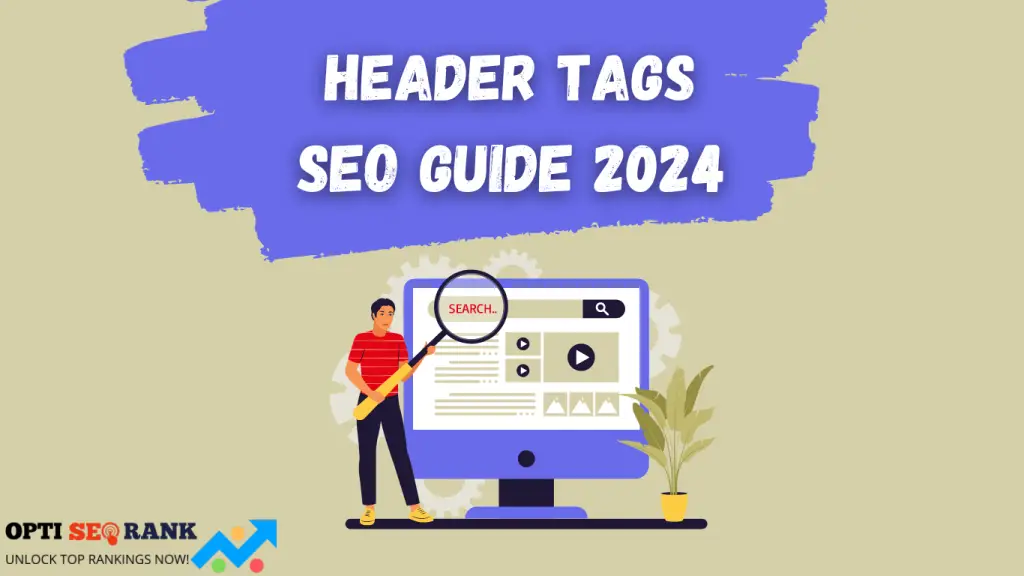Master on-page SEO success in 2024 by optimizing content, improving user experience, and using effective keywords. Stay ahead with these essential strategies.
On-page SEO is crucial for better search engine rankings and increased organic traffic. In 2024, mastering elements like keyword optimization, content quality, and user experience is key. Focus on creating informative and engaging content that meets user intent. Ensure your website is fast, mobile-friendly, and easy to navigate.
Use internal linking to enhance site structure and improve page authority. Regularly update content to keep it fresh and relevant. By implementing these strategies, you can achieve sustainable on-page SEO success and stay ahead of the competition.
Introduction To On-page Seo

On-Page SEO is vital for enhancing website visibility. It involves optimizing each webpage to rank higher and gain more relevant traffic. This includes both content and HTML source code. Effective On-Page SEO ensures your site is easily accessible and engaging for users and search engines.
Importance Of On-page Seo
On-Page SEO boosts your website’s search engine rankings. It helps search engines understand your content better. Proper On-Page SEO leads to improved user experience. It includes optimizing title tags, meta descriptions, and header tags. High-quality, relevant content is crucial.
Well-optimized pages attract more organic traffic. They reduce bounce rates and increase time spent on the site. On-Page SEO contributes to higher click-through rates (CTR). It also impacts your overall domain authority.
Current Trends In 2024
On-Page SEO in 2024 focuses on user intent and content relevance. Search engines now prioritize pages that satisfy user queries. Optimizing for voice search is essential. People use more conversational queries through smart devices.
Mobile-first indexing remains crucial. Ensure your site is mobile-friendly and loads quickly. Core Web Vitals are key performance metrics. They measure user experience, focusing on loading, interactivity, and visual stability.
Structured data and schema markup enhance how search engines read your site. This leads to rich snippets and better visibility. Video content optimization is also trending. Videos engage users and can boost rankings.
| Element | Importance | Trend in 2024 |
| Title Tags | High | Optimized for user intent |
| Meta Descriptions | High | Include primary keywords |
| Header Tags | Medium | Structured and relevant |
| Core Web Vitals | High | Focus on performance |
| Schema Markup | Medium | Enhance search visibility |
Adapting to these trends ensures your site stays competitive. Stay updated and continuously improve your On-Page SEO strategies.
Keyword Research
Keyword Research is the foundation of any successful on-page SEO strategy. In 2024, mastering keyword research is crucial for improving your site’s visibility. It helps you find the right search terms to attract your target audience. This section explores how to find relevant keywords and the importance of long-tail keywords.
Finding Relevant Keywords
Finding relevant keywords is the first step in keyword research. Use tools like Google Keyword Planner and Ahrefs. These tools help you discover what your audience searches for. Look for keywords that have high search volume but low competition. This helps you rank higher on search engines.
Create a list of potential keywords. Organize them in a table for easy access:
| Keyword | Search Volume | Competition |
| SEO tips | 10,000 | Medium |
| on-page SEO | 8,000 | Low |
| keyword research tools | 5,000 | High |
Long-tail Keywords
Long-tail keywords are longer and more specific phrases. They often have lower search volume. But they attract a more targeted audience. For example, “on-page SEO tips for beginners” is a long-tail keyword. These keywords are less competitive and easier to rank for.
Here are some benefits of using long-tail keywords:
- Higher conversion rates
- Less competition
- More targeted traffic
Include long-tail keywords in your content. Use them in headings, meta descriptions, and throughout your text. This helps search engines understand your content better.
Content Optimization
Content Optimization is crucial for achieving On-Page SEO Success in 2024. It enhances user experience and search engine rankings. Key elements include Quality Content Creation and Keyword Placement. Master these aspects to improve your website’s visibility.
Quality Content Creation
Creating high-quality content is essential. It attracts visitors and keeps them engaged. Focus on providing valuable information that solves problems. Ensure your content is original, well-researched, and engaging.
- Use simple language.
- Break text into short paragraphs.
- Incorporate visual elements like images and videos.
- Update content regularly.
Keyword Placement
Keyword Placement helps search engines understand your content. Place keywords strategically for better rankings. Use primary keywords in the title, headings, and the first paragraph.
| Element | Placement |
| Title | Include the primary keyword. |
| Headings | Use keywords in H1, H2, and H3 tags. |
| Content | Incorporate keywords naturally within the text. |
| Meta Description | Add keywords to the meta description for better CTR. |
Avoid keyword stuffing. Use synonyms and related terms. This enhances readability and maintains a natural flow.
Title Tags And Meta Descriptions
Title tags and meta descriptions are crucial for on-page SEO. They help search engines understand your content. They also attract clicks from users. Crafting these elements effectively can improve your site’s visibility.
Crafting Effective Title Tags
Title tags are the first impression users get of your page. They appear in search engine results and browser tabs. A good title tag is concise and informative.
- Keep it under 60 characters.
- Include your main keyword.
- Make it unique for each page.
- Use action words to entice clicks.
Here is an example of a well-optimized title tag:
Notice the use of keywords and a compelling promise. This draws users in and signals relevance to search engines.
Optimizing Meta Descriptions
Meta descriptions summarize your page content. They appear below the title tag in search results. A well-written meta description can boost click-through rates.
- Keep it under 160 characters.
- Include your main keyword.
- Write in active voice.
- Provide a clear call-to-action.
Here is an example of an effective meta description:
This meta description is concise and uses relevant keywords. It encourages users to click by promising useful information.
| Element | Best Practices |
| Title Tag | Use main keyword, keep under 60 characters, unique for each page. |
| Meta Description | Use main keyword, keep under 160 characters, clear call-to-action. |
Header Tags
Header tags are essential in structuring your web content. They help search engines understand the hierarchy of your content. They also improve the user experience by making your content more readable.
Using H1 Tags
The H1 tag is the main title of your page. Each page should have only one H1 tag. This tag tells search engines what your page is about. Use your primary keyword in the H1 tag.
Example:
On-Page SEO Success 2024
Ensure your H1 tag is clear and concise. It should accurately describe the page content.
Structuring With H2 To H6
Use H2 to H6 tags to create a logical structure. These tags break down content into sections and sub-sections.
Example:
Introduction to On-Page SEO
Importance of SEO
Benefits of Proper SEO
Increased Traffic
Better User Experience
Use H2 tags for main sections. Use H3 to H6 tags for sub-sections. This creates a clear and organized structure. It helps users and search engines navigate your content.
Here is a quick reference table for header tags:
| Header Tag | Usage |
| Main title, used once per page | |
| Main sections of the content | |
| Sub-sections of H2 | |
| Sub-sections of H3 | |
| Sub-sections of H4 | |
| Sub-sections of H5 |
Remember to use header tags logically. It makes your content more readable and SEO-friendly.
Url Structure
Creating a strong URL structure is vital for On-Page SEO Success in 2024. URLs help search engines understand your page’s content. They also improve user experience. A well-structured URL can boost your rankings.
Seo-friendly Urls
SEO-friendly URLs are clean, simple, and easy to read. They must include relevant keywords and avoid unnecessary characters. A good URL should give a clear idea of the page content.
Here are some tips for creating SEO-friendly URLs:
- Keep URLs short and descriptive.
- Use hyphens to separate words.
- Avoid using special characters and numbers.
- Incorporate primary keywords.
- Use lowercase letters only.
Best Practices
Following best practices ensures your URL structure is optimized for search engines and users. Below is a table highlighting key best practices:
| Best Practice | Description |
| Use Simple Words | Use words that are easy to understand. |
| Include Keywords | Incorporate main keywords naturally. |
| Avoid Dynamic URLs | Use static URLs instead of dynamic ones. |
| Maintain Consistency | Keep URL structure consistent across the site. |
Following these tips and best practices will help you create effective URL structures. These structures will improve your site’s SEO and user experience.
Image Optimization
Image optimization is crucial for on-page SEO success in 2024. Properly optimized images can boost your website’s load speed and improve user experience. It also helps search engines understand your content better. Let’s dive into the key aspects of image optimization, focusing on alt text importance and file size and format.
Alt Text Importance
Alt text is the text that describes your image. It helps search engines understand the image content. This is essential for image SEO.
- Improves Accessibility: Alt text helps visually impaired users. Screen readers use alt text to describe images.
- Boosts SEO: Search engines index alt text. This helps your images appear in search results.
- Enhances User Experience: Broken images show alt text instead. This maintains a positive user experience.
File Size And Format
The file size and format of your images affect your website’s load speed. A faster load speed improves your site’s SEO.
| Format | Best Use |
| JPEG | Best for photos with many colors |
| PNG | Best for images with transparency |
| WebP | Best for high-quality images with smaller file sizes |
To optimize image size, use compression tools. These tools reduce file size without losing quality.
- Use tools like TinyPNG or ImageOptim.
- Choose the right format for each image.
- Always test your website’s load speed after optimization.
By focusing on alt text and file size, you can improve your image SEO. This will help your website rank higher in search results in 2024.
Internal Linking
Internal linking is a key part of on-page SEO. It helps search engines understand your website better. Internal links connect your content, making it easier to navigate. This boosts your site’s visibility and ranking.
Linking Strategies
Effective linking strategies enhance your SEO efforts. Here are some tips:
- Link to relevant content within your site.
- Use a mix of do-follow and no-follow links.
- Ensure links are natural and add value.
| Strategy | Benefit |
| Contextual Links | Improves user experience and SEO. |
| Breadcrumbs | Helps users navigate easily. |
| Footer Links | Provides additional navigation options. |
Anchor Text
Anchor text is the clickable part of a hyperlink. It tells users and search engines about the linked page. Good anchor text is descriptive and relevant.
- Use descriptive keywords in your anchor text.
- Avoid using generic phrases like “click here”.
- Keep anchor text short and to the point.
Here’s an example of good anchor text:
SEO tips
And here’s an example of bad anchor text:
Click here
Mastering internal linking is crucial for SEO success in 2024. It ensures your content is easily accessible and boosts your site’s performance.
Mobile-friendliness
Mobile-friendliness is crucial for on-page SEO success in 2024. With more users accessing websites via mobile devices, optimizing for mobile is essential. A mobile-friendly site improves user experience and boosts search engine rankings.
Responsive Design
A responsive design ensures your website adjusts to any screen size. This adaptability improves user engagement and reduces bounce rates. Follow these tips for a responsive design:
- Use flexible grid layouts.
- Optimize images for different screen sizes.
- Ensure clickable elements are easily accessible.
Mobile Seo Tips
Implementing mobile SEO tips can enhance your site’s performance on mobile devices. Consider these strategies:
- Page Speed: Ensure fast load times for mobile users.
- Mobile-Friendly Content: Use short paragraphs and bullet points.
- Local SEO: Optimize for local searches with mobile users in mind.
Here’s a table summarizing key mobile SEO tips:
| Tip | Description |
| Page Speed | Fast loading times improve user experience. |
| Mobile-Friendly Content | Use short paragraphs and bullet points. |
| Local SEO | Optimize for local searches. |
By focusing on mobile-friendliness, you can achieve on-page SEO success in 2024. Improve your site’s visibility and user experience with these tips.
Page Load Speed
Page load speed is crucial for SEO success in 2024. A fast-loading website improves user experience and ranks higher on search engines. Slow-loading pages frustrate users and increase bounce rates. Let’s dive into key elements that enhance page load speed.
Speed Optimization Techniques
To improve page load speed, use these effective techniques:
- Minimize HTTP Requests: Reduce the number of elements on your page.
- Enable Compression: Use Gzip to compress files.
- Optimize Images: Compress images without losing quality.
- Minify CSS, JavaScript, and HTML: Remove unnecessary characters from your code.
- Use Browser Caching: Store static files in users’ browsers for faster load times.
- Improve Server Response Time: Choose a reliable hosting provider.
Tools For Measuring Speed
Use these tools to measure and analyze your website’s speed:
| Tool | Description |
| Google PageSpeed Insights | Analyzes your site and provides performance suggestions. |
| GTmetrix | Offers detailed reports on your website’s speed and performance. |
| Pingdom | Tests the load time of your site from various locations. |
| WebPageTest | Provides a detailed analysis and suggestions for improvement. |
Regularly monitor your website speed using these tools. Make necessary adjustments to ensure optimal performance. Fast-loading pages enhance user experience and improve SEO rankings.
User Experience
Creating a stellar user experience (UX) is crucial for on-page SEO success in 2024. A website that is easy to navigate and visually appealing keeps visitors engaged. This leads to longer site visits, lower bounce rates, and higher conversion rates. Let’s dive into the key elements of user experience that you need to master.
Engaging Design Elements
An engaging design captures the visitor’s attention immediately. Use vibrant colors, intuitive layouts, and high-quality images. A clean and simple design often works best. Make sure your fonts are readable and your call-to-action buttons stand out.
Incorporate interactive elements like sliders, forms, and clickable images. These keep users engaged and encourage them to explore more. A well-designed website builds trust and credibility.
| Design Element | Impact |
| High-Quality Images | Enhances visual appeal |
| Readable Fonts | Improves text clarity |
| Interactive Elements | Boosts user engagement |
Reducing Bounce Rate
A high bounce rate indicates visitors leave your site quickly. To reduce this, make sure your content is relevant and engaging. Use clear headings and subheadings to guide visitors through your content.
Loading speed is also crucial. A slow website frustrates users and increases bounce rates. Use optimized images and leverage browser caching to improve speed. Ensure your site is mobile-friendly as many users browse on their phones.
- Optimize images for faster loading.
- Use clear and concise headings.
- Ensure your site is mobile-friendly.
- Improve server response time.
By mastering user experience elements, you can greatly enhance your on-page SEO efforts. A well-designed and engaging website keeps visitors coming back.
Frequently Asked Questions
What Are The Three Most Important Elements In On-page Seo?
The three most important elements in on-page SEO are high-quality content, optimized meta tags, and proper use of header tags.
What Are The 3 Core Must Haves Of Seo?
The three core must-haves of SEO are quality content, relevant keywords, and strong backlinks. These elements boost search rankings effectively.
Which Strategies Can Help With Your On-page Seo?
Optimize your on-page SEO with these strategies: use relevant keywords, create quality content, optimize images, improve page load speed, and use internal links.
How To Get 100% Seo?
Achieving 100% SEO isn’t possible, but you can improve significantly. Focus on high-quality content, keyword optimization, mobile-friendliness, fast loading speeds, and strong backlinks. Regularly update your content and monitor analytics for continuous improvement.
Conclusion
Mastering on-page SEO elements is crucial for 2024 success. Focus on quality content, optimized keywords, and mobile-friendly design. Regularly update your strategies to stay ahead. Implement these tips to boost your search engine rankings. Achieve better visibility and drive more organic traffic to your site.
Keep refining your techniques for continued growth.



